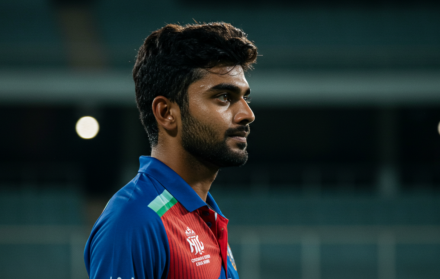
What Are The Financial Aspects Of Professional Cricket
Professional cricket, a sport with a rich history and global appeal, involves complex financial aspects that significantly impact the players, teams, and governing bodies. Understanding the financial aspects of professional cricket is crucial for anyone interested in the economic side of the game. From player salaries and sponsorship deals to broadcasting rights and tournament revenues, the financial ecosystem of cricket is multifaceted and dynamic.
One of the primary sources of income for professional cricketers is their salary, which can vary greatly depending on their contract type and the leagues they participate in. Top players often secure lucrative contracts in domestic and international leagues, reflecting their skill and marketability. Additionally, performance bonuses and match fees contribute to a player’s overall earnings, incentivizing high performance and consistent play.
Sponsorship deals are another significant financial component in professional cricket. Players, teams, and even tournaments attract sponsors who see value in associating their brands with the sport. These deals often include endorsements, merchandise sales, and promotional appearances, providing substantial revenue streams. High-profile players frequently sign multimillion-dollar endorsement contracts with major brands, enhancing their financial stability and market presence.
Broadcasting rights constitute a major revenue source for cricket governing bodies and leagues. The sale of broadcasting rights to television networks and streaming platforms generates significant income, which is often reinvested into the sport. These deals ensure that fans around the world can enjoy live cricket matches, increasing the sport’s global reach and popularity. The competition for broadcasting rights can be fierce, with networks vying for the opportunity to showcase popular tournaments and matches.
Cricket tournaments, both domestic and international, play a crucial role in the financial landscape of the sport. The structure and organization of these tournaments, including prize money distribution and sponsorship, are key factors in their economic success. Understanding how cricket tournaments work provides insight into the financial planning and logistics involved in hosting successful events. These tournaments often draw large audiences, both in-stadium and via broadcasts, contributing to their financial viability.
The rise and influence of women’s cricket have also brought significant financial changes to the sport. Increased investment in women’s cricket, through better pay, more sponsorship deals, and greater media coverage, is helping to bridge the gender gap in cricket. The growing popularity of women’s cricket tournaments has attracted new audiences and sponsors, further diversifying the sport’s financial base.
Coaching is another critical aspect of professional cricket that involves substantial financial investment. The role of a cricket coach extends beyond training players; it includes strategy development, team management, and performance analysis. Understanding the role of a cricket coach highlights the importance of these professionals in enhancing team performance and their contribution to the financial success of cricket teams. High-profile coaches command significant salaries and are often pivotal in attracting sponsorship and investment.
Player development and scouting also represent important financial commitments. Investing in youth academies and training facilities ensures a steady pipeline of talent for the future. These investments are crucial for maintaining competitive teams and sustaining the sport’s popularity. Additionally, the financial support for grassroots programs helps in identifying and nurturing young talent, which can eventually lead to professional success and financial gain for the players and their teams.
The greatest cricket players have often contributed to the sport’s financial success through their exceptional performances and charismatic appeal. Legends of the game draw crowds, attract sponsorships, and boost merchandise sales, creating a lasting financial impact on the sport. Their influence extends beyond the field, inspiring new generations of players and fans, thereby sustaining cricket’s economic and cultural significance.
In conclusion, the financial aspects of professional cricket are intricate and influential, affecting every level of the sport. From player earnings and sponsorship deals to broadcasting rights and tournament revenues, these financial elements shape the way cricket is played, promoted, and perceived globally. Understanding these dynamics offers a comprehensive view of cricket’s economic environment and underscores the importance of financial management in sustaining and growing the sport.
Player Salaries and Contracts

One of the most visible aspects of professional cricket’s financial landscape is player salaries and contracts. Top-tier cricket players can earn substantial incomes through various forms of compensation, including match fees, annual contracts, and performance bonuses. The financial rewards for players vary significantly depending on their skill level, reputation, and the leagues or tournaments they participate in.
In international cricket, players receive match fees for each game they play. These fees can vary based on the format of the match (Test, One Day International, or Twenty20) and the player’s role in the team. Additionally, players who perform exceptionally well may receive performance bonuses, such as Man of the Match or Man of the Series awards, which provide additional financial incentives.
Apart from match fees, many players are contracted by their national cricket boards. These contracts, often categorized into different grades (A, B, C, etc.), provide a guaranteed annual income. The top-grade contracts offer the highest salaries and are typically awarded to the most senior and consistent performers. These contracts also include benefits such as health insurance, retirement plans, and travel allowances, providing financial stability for the players.
Domestic leagues, particularly the Indian Premier League (IPL), have revolutionized player earnings in cricket. The IPL, with its lucrative contracts and significant media coverage, offers players the opportunity to earn millions of dollars over a few weeks of competition. Players are auctioned, and franchises bid for their services, driving up the prices for the most sought-after talents. Other leagues, such as the Big Bash League (BBL) in Australia and the Pakistan Super League (PSL), also offer attractive salaries, though not on the same scale as the IPL.
Sponsorships and Endorsements
Sponsorships and endorsements are major sources of income for professional cricketers and teams. Companies are willing to invest substantial amounts in cricket due to its global reach and popularity. Sponsorship deals can range from team sponsorships, where a brand becomes the official sponsor of a national or franchise team, to individual player endorsements, where players promote products or services.
Team sponsorships often involve large financial commitments. Brands pay to have their logos displayed on team jerseys, training kits, and other merchandise. These deals provide significant revenue streams for cricket boards and franchises, helping to cover operational costs and invest in player development and infrastructure. For example, the Board of Control for Cricket in India (BCCI) has secured lucrative sponsorship deals with major companies, boosting its financial resources.
Individual endorsements are another lucrative aspect of cricket finances. Top players, especially those with a global fanbase, can command high fees for endorsing products ranging from sports equipment and apparel to consumer goods and financial services. Brands leverage the popularity and influence of these players to reach wider audiences and enhance their market presence. Players like Virat Kohli, MS Dhoni, and Ben Stokes have secured multi-million dollar endorsement deals, significantly augmenting their income beyond match fees and contracts.
The commercial appeal of cricketers extends beyond traditional endorsements. Players often engage in promotional activities, social media campaigns, and personal appearances for brands. With the rise of digital media, cricketers have become influential figures on platforms like Instagram, Twitter, and YouTube, creating additional revenue opportunities through sponsored posts and collaborations with brands.
Broadcasting Rights and Media Revenue

Broadcasting rights are a crucial financial pillar for professional cricket. The sale of television and digital broadcasting rights generates substantial revenue for cricket boards, leagues, and tournaments. These deals involve media companies paying hefty sums to secure the rights to broadcast cricket matches live to audiences worldwide.
The Indian Premier League (IPL) is a prime example of the financial impact of broadcasting rights. The IPL’s broadcasting rights are among the most expensive in the world of sports. In 2017, Star India secured the global broadcasting rights for the IPL for a staggering $2.55 billion over five years. This deal underscored the immense commercial value of cricket and set a benchmark for other leagues and tournaments.
International cricket also benefits significantly from broadcasting revenue. Cricket boards negotiate deals with media companies to broadcast bilateral series, ICC events, and other tournaments. These deals are often multi-year agreements that provide financial stability and allow cricket boards to invest in the sport’s development. For instance, the England and Wales Cricket Board (ECB) and Cricket Australia have secured lucrative broadcasting deals that contribute significantly to their annual revenue.
Digital media has further expanded the revenue potential of broadcasting rights. With the rise of streaming platforms and mobile applications, cricket matches are now accessible to a global audience beyond traditional television. Digital rights deals complement traditional broadcasting agreements, providing additional revenue streams. Platforms like Hotstar, SonyLIV, and ESPN+ offer subscription-based services that attract cricket fans worldwide, enhancing the sport’s financial ecosystem.
The revenue generated from broadcasting rights is often shared among various stakeholders, including cricket boards, franchises, and players. This revenue distribution ensures that the financial benefits of the sport reach different levels of the cricketing hierarchy, from grassroots development to elite professional competitions.
Ticket Sales and Match-Day Revenue
Ticket sales and match-day revenue are significant components of cricket’s financial landscape. Hosting cricket matches, whether domestic leagues or international fixtures, attracts large crowds and generates substantial income from ticket sales, hospitality packages, merchandise, and concessions.
High-profile matches, such as Test series, One Day Internationals, and T20 internationals, draw significant spectator interest. Iconic venues like Lord’s, the Melbourne Cricket Ground (MCG), and Eden Gardens regularly see sell-out crowds for major fixtures. Ticket revenue from these matches contributes to the financial health of cricket boards and stadium operators.
Domestic leagues, particularly the IPL, also rely heavily on ticket sales and match-day revenue. The IPL’s fanbase is known for its passion and enthusiasm, filling stadiums across India. The revenue generated from ticket sales, along with corporate hospitality and sponsorship deals, supports the franchises’ financial operations and player salaries.
Match-day revenue extends beyond ticket sales. Hospitality packages, VIP boxes, and premium seating options provide additional income. Fans often purchase official merchandise, such as team jerseys, caps, and memorabilia, contributing to the financial success of cricket events. Concession stands and food and beverage sales at stadiums also add to match-day revenue.
The COVID-19 pandemic had a significant impact on match-day revenue, as matches were played behind closed doors or with limited spectators. However, the gradual return of fans to stadiums has revitalized this revenue stream, highlighting its importance to the overall financial ecosystem of cricket.
Economic Impact on Hosting Countries

Hosting major cricket events, such as ICC tournaments and bilateral series, has a significant economic impact on the host countries. These events attract international tourists, boost local economies, and create job opportunities, contributing to the overall financial benefits of the sport.
International Cricket Council (ICC) events, such as the Cricket World Cup, ICC T20 World Cup, and ICC Champions Trophy, generate substantial economic activity. Host countries invest in infrastructure, stadium upgrades, and hospitality services to accommodate the influx of fans and teams. The tourism sector benefits from increased hotel bookings, restaurant patronage, and local transportation usage.
The Cricket World Cup, one of the most prestigious tournaments in the sport, exemplifies the economic impact of hosting major cricket events. The 2019 Cricket World Cup in England and Wales, for example, attracted fans from around the world, resulting in significant spending on accommodation, food, travel, and entertainment. The tournament generated millions of dollars in economic activity, benefiting local businesses and the broader economy.
Bilateral series also contribute to the economic impact of cricket. High-profile series, such as the Ashes between England and Australia, attract large numbers of fans and media attention. These series boost tourism, with fans traveling to watch matches, explore host cities, and engage in cultural activities. The influx of visitors stimulates local economies, supporting businesses and creating employment opportunities.
The economic benefits of hosting cricket events extend beyond direct spending. Infrastructure investments, such as stadium construction and upgrades, leave a lasting legacy for the host country. Improved facilities can be used for future sporting events, concerts, and community activities, providing ongoing economic and social benefits.
Governance and Financial Management
Effective governance and financial management are essential for the sustainability and growth of professional cricket. Cricket boards, leagues, and governing bodies play a crucial role in managing the sport’s finances, ensuring transparency, accountability, and strategic investment.
Cricket boards are responsible for overseeing the financial operations of the sport in their respective countries. They manage revenue streams, allocate funds for development programs, and ensure that financial resources are used efficiently. Governance structures, such as executive committees and financial oversight bodies, provide checks and balances to maintain financial integrity.
Transparency in financial management is critical for maintaining the trust of stakeholders, including players, sponsors, and fans. Many cricket boards publish annual financial reports that detail their revenue, expenses, and investment strategies. These reports provide insights into the financial health of the sport and demonstrate accountability to stakeholders.
Financial management also involves strategic investment in grassroots development, infrastructure, and player welfare. Investing in grassroots programs ensures a steady pipeline of talent, while infrastructure development enhances the quality of facilities and fan experiences. Player welfare initiatives, such as health insurance, retirement plans, and mental health support, contribute to the overall well-being of cricketers.
The International Cricket Council (ICC) plays a key role in global cricket governance, managing international tournaments, setting regulations, and distributing revenue among member countries. The ICC’s revenue-sharing model ensures that financial resources are distributed equitably, supporting the development of cricket in both established and emerging nations.
Conclusion: Navigating the Financial Ecosystem of Professional Cricket

The financial aspects of professional cricket are complex and multifaceted, encompassing player salaries, sponsorships, broadcasting rights, match-day revenue, and the economic impact on host countries. Understanding these financial dynamics provides insight into how the sport operates and thrives in today’s economy. Effective governance and financial management are essential for the sustainability and growth of cricket, ensuring that the sport continues to flourish on a global scale.
By exploring the financial ecosystem of professional cricket, stakeholders can make informed decisions that support the sport’s development and promote its economic health. The interplay of revenue streams, investment strategies, and governance structures highlights the importance of a holistic approach to managing the finances of cricket, ensuring a bright future for the sport and its stakeholders.
Player salaries represent a significant portion of cricket’s financial landscape, reflecting the value and talent of professional athletes. Sponsorships and broadcasting rights are crucial revenue streams, providing substantial financial support and global exposure for the sport. These elements not only enhance the players’ earnings but also contribute to the overall financial stability of cricket organizations.
Match-day revenue, generated from ticket sales, merchandise, and concessions, adds another layer to cricket’s financial ecosystem. This revenue is vital for host countries and venues, boosting local economies and creating employment opportunities. The economic impact of hosting cricket matches extends beyond the stadium, benefiting businesses and communities in the surrounding areas.
Effective governance and financial management play pivotal roles in maintaining cricket’s economic health. Transparent and strategic financial practices ensure that resources are allocated efficiently, fostering growth and sustainability. Governance structures must adapt to the evolving landscape of professional sports, incorporating best practices and innovative approaches to financial management.
The financial ecosystem of professional cricket is intricate and essential for the sport’s success and growth. By understanding and managing the various financial components, stakeholders can ensure that cricket continues to thrive globally. The strategic interplay of player salaries, sponsorships, broadcasting rights, match-day revenue, and effective governance underscores the importance of a comprehensive approach to financial management in cricket, paving the way for a prosperous future for the sport and its stakeholders.





